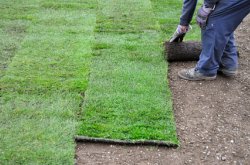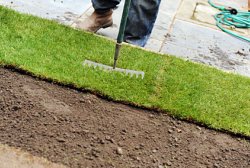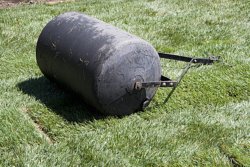Installing sod is easy but it needs to be laid right. How to lay sod to ensure the best results.
Easy? Well…it is labor intensive but the process is pretty simple.

Preparing the Soil for Planting Grass
Have your soil tested before prepping. The results will tell you what amendments (lime, compost, etc.) need to be added.
Renovating an Old Lawn: Old grass can be stripped with a sod cutter or sprayed with Roundup weed killer 2 weeks before sodding – the dead grass can then be tilled. Tip: Mark sprinkler heads before tilling or sod cutting.
Rough grade and rake up any rocks and debris.
Add topsoil and amendments and then till to a depth of 4 to 6 inches. Next, apply a starter fertilizer and work it into the top inch of the soil.
The finished grade should be 1 inch below edges, sidewalks, driveways and curbs to make room for the new sod. Tip: Drag a section of chain link fence behind a lawn tractor to smooth large areas.
After finishing grading, roll with a water-filled lawn roller to firm up the soil enough to be walked on.
Starting a New Lawn: If possible, remove constriction debris – buried wood, stumps, and large roots. Large pieces of decomposing wood will cause Mushrooms in lawns and can also cause fairy rings. Tilling and grading is the same process as renovating (see above paragraphs).

Start Laying Sod
Sod deteriorates quickly in warm weather! Install it as soon as it is delivered. Whatever you cannot lay right away should be stored in a shady spot – unrolled and kept moist.
Tip: To make your job easier – ask the delivery driver to spread the pallets around the job site (or close to where you’re working) so the rolls don’t have to be carried far.
Lightly water to cool the soil. It should be moist – not wet – at the time of sodding. Why? Because the sun will heat up bare soil and laying sod on hot, dry ground will slow rooting – even if properly watered after installation.
Start by establishing a straight line for the first row. Run a string line or follow a sidewalk or driveway. Subsequent rows should be staggered (in a brick-like pattern) so that the seams do not line up. Staggering the rolls makes them fit tighter. Tight seams keep the sod from drying quickly and help to hold it in place. The finished lawn will also look nicer!

Tips: How to Lay Sod
- Butt the edges and seams tight without overlapping or leaving gaps. Tuck seams so they are not facing up – exposing soil and roots.
- Handle with care to avoid tearing or stretching. Sod tends to shrink and if stretched it will shrink even more – leaving large gaps.
- Lay sod across slopes – not up and down – and use stakes or staples on steep slopes.
- Avoid indentions and pockets. Do not walk or kneel on the newly laid sod while working. Use a piece of plywood to kneel on.
- Use trimmings to patch holes and gaps. Smaller gaps should be filled with topsoil.
- Box cutters, linoleum knives, machetes and edging spades are good sod-trimming tools.
- To make a tight-fitting patch: find a piece that is larger than the gap. Lay it over the gap overlapping the bottom pieces. Use a knife to trim the patch cutting through the top and bottom pieces of sod.
- Avoid using small strips and pieces on the outer edges – they dry out quickly.
- Roll the new lawn when finished. Rolling removes air pockets and improves root-to-soil contact.
- Start watering as soon as possible.

